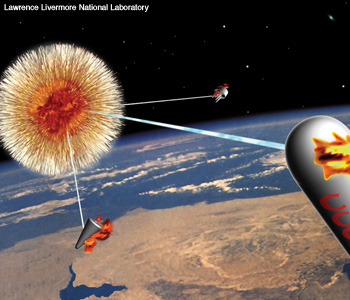 This artist’s concept shows beams from three X-ray rods destroying Cold War targets after detonation of the bomb powering the X-ray rods. If deployed in space, each of the thin rods of the X-ray laser weapon would be aimed at an enemy missile. From Joseph Nilsen, "Legacy of the X-ray Laser Program," Lawrence Livermore National Laboratory report.
This artist’s concept shows beams from three X-ray rods destroying Cold War targets after detonation of the bomb powering the X-ray rods. If deployed in space, each of the thin rods of the X-ray laser weapon would be aimed at an enemy missile. From Joseph Nilsen, "Legacy of the X-ray Laser Program," Lawrence Livermore National Laboratory report.
After Ted Maiman demonstrated the first laser in 1960, the optical community immediately began seeking shorter and shorter wavelengths, through the visible and into the ultraviolet. By the early 1970s, lasers had reached the vacuum ultraviolet. However, the push toward shorter wavelengths stalled around 110 nm as problems emerged with short-wavelength laser physics.
As the energy of a laser transition increases, the excited state lifetime decreases, and the pump energy required to produce a population inversion increases. In fact, the two effects combine, so pump energy must be concentrated in a pump pulse that can be deposited very quickly in the laser material. A further complication is the lack of materials able to reflect or transmit light efficiently in the deep or extreme ultraviolet, making conventional mirrors and windows impractical.
Faced with those problems, developers shifted their approach. Instead of trying to make a laser oscillator, they sought to highly excite cylindrical plasmas that could generate intense X-ray pulses by amplifying stimulated emission along their lengths. The obvious way to excite the plasma was by firing intense optical laser pulses onto a target, and fortunately, high-power lasers were becoming available. Although the theory was promising, scientists’ experiments fell short of X-ray laser threshold.
A false alarm in Utah
The first big news in the quest for an X-ray laser was a report by John G. Kepros and colleagues at the University of Utah in the July 1972 Proceedings of the National Academy of Sciences. They had dissolved copper sulphate in Knox unflavored gelatin and spread thin layers of the mixture onto microscope slides, then illuminated them with pulses to 30 J from a 20-ns neodymium glass laser. When they placed X-ray film, shielded by dark paper and aluminum foil, behind the sample, and fired laser pulses at the material, well-aligned spots appeared on the X-ray film. Kepros concluded that the spots had recorded a hard X-ray laser.
However, the flurry of attention faded quickly when other labs could not reproduce the results. Outside researchers concluded that the pump laser lacked enough power to make an X-ray laser. The incident was soon forgotten, and no one has ever conclusively identified what spotted the film.
The false alarm did not dampen the optimism of X-ray laser researchers. After a meeting in Washington the following year, conference organizer Ronald Andrews of the Naval Research Laboratory predicted that the first X-ray laser would be a highly ionized plasma a few millimeters long and a few micrometers in diameter, excited by about a joule of energy in a picosecond pulse. Free electrons dropping back into lower energy levels of the plasma ions would produce stimulated emission in a traveling-wave amplifier, with wavelengths of 0.12 to 1.2 nm, corresponding to transition energies of 1 to 10 keV.
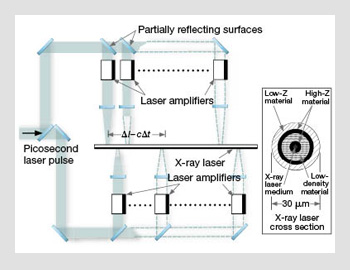 Conceptual design for an X-ray laser. A long, thin X-ray laser could be pumped by splitting a laser pulse in half, then picking off part of the energy from the pulse at a series of points to illuminate the rod along its whole length. Chapline and Wood proposed this scheme in 1975.
Conceptual design for an X-ray laser. A long, thin X-ray laser could be pumped by splitting a laser pulse in half, then picking off part of the energy from the pulse at a series of points to illuminate the rod along its whole length. Chapline and Wood proposed this scheme in 1975.
The primary applications were expected to be in materials science and fundamental research. “Grandiose applications, which require sizable amounts of power, such as communications and weapons, are too far in the future to speculate about,” said Andrews.
Detailed models showed that pump pulses would have to be extremely short and powerful. In a 1975 review paper, George Chapline and Lowell Wood of the Lawrence Livermore National Laboratory estimated the radiative lifetime of an X-ray laser transition would be about 10-15 s x the square of the wavelength in angstroms. Pumping a 10-keV (0.12-nm) laser would require around a watt per atom in an unattainably short pulse.
However, they wrote that the pump requirement would be reduced to the order of a terawatt for a 1-keV (1.2-nm) laser. Livermore researchers were thinking of tailoring pulses from its then-new terawatt-class Cyclops fusion laser to produce a long, thin plasma. The pulse would be split into parts, which would be delivered to spots along the side of the target for traveling-wave pumping.
Meanwhile, a handful of new experiments produced modestly encouraging but far from conclusive results. Pierre Jaegle at the University of Paris South in Orsay reported soft X-ray superradiance in an expanding aluminum-vapor plasma. Russian physicists reported emission from highly ionized calcium and titanium, but did not claim laser operation. There were occasional rumors about breakthroughs hidden behind the Iron Curtain, but no conclusive evidence ever surfaced.
That wasn’t enough for the Defense Advanced Research Projects Agency (DARPA), which had supported most U.S. X-ray laser research. DARPA typically funds promising ideas for a few years, then drops programs that don’t make enough progress to transfer to other agencies. X-ray lasers didn’t make the cut, and in 1976 DARPA shifted its laser research support to the then-new free-electron laser.
Some research continued outside the United States, but no one made notable progress until 1980, when Geoffrey Pert at the University of Hull in Britain reported “laser gain” at 18.2 nm. He and his colleagues used 5-J, 100-ps pulses from a neodymium-glass laser focused onto a 2 mm x 40 µm line to vaporize carbon fibers. Recombination of free electrons with hydrogen-like carbon ions (C+5) generated stimulated emission with a gain-length product of 5. That was much higher than the 0.1 reported by Jaegle, but not enough to be considered conclusive.
Livermore’s two X-ray laser programs
After DARPA stopped its support, Livermore became the center of U.S. X-ray laser research. It had both the people and the resources needed to tackle a problem that some thought was impossible. It was the country’s lead laboratory in fusion lasers, and the lab was involved in the nuclear weapons program, which could also deliver the short, intense bursts of energy that might pump an X-ray laser.
Chapline recalls that he and Wood first thought about a bomb-driven X-ray laser while walking in the foothills above Livermore during the early 1970s. Congress had asked the weapons labs if they could do something with nuclear-weapon technology besides designing warheads, and the two decided that pumping an X-ray laser would be an interesting idea.
But years would pass before Chapline would come up with a workable concept. In the interim, he and Wood considered how pulses from a fusion laser might drive an X-ray laser. They suggested that idea in their 1975 review, but didn’t give many details. They did not mention nuclear pumping, but they did write that “exposing a target to an X-ray flash of very high intensity” might produce an X-ray population explosion, although adding that no “conventional flash X-ray sources” could supply enough energy. What they didn’t say was that nuclear bombs produce extremely intense X-ray flashes.
By the late 1970s, Livermore was considering both bombs and fusion lasers to pump X-ray lasers. Although these approaches might sound like the old “telephone pole theory” of lasing—i.e., hit anything with enough energy, even a telephone pole, and it would lase—the process was actually much more complex, because it had to selectively populate the upper levels of a laser transition rather than just heat the target.
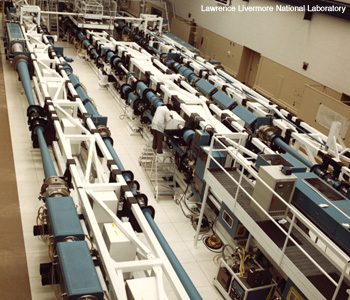 Two-beam Novette laser at Livermore generated second-harmonic pulses of green light for the first laboratory X-ray laser.
Two-beam Novette laser at Livermore generated second-harmonic pulses of green light for the first laboratory X-ray laser.
“There are a lot of wrong ways to do it,” said Peter Hagelstein, now at MIT, who went to Livermore in the mid-1970s and wrote his dissertation on how to make an X-ray laser. Wood told him that, since nobody knew how to make an X-ray laser, he should pick a scheme assuming it would fail, but try to learn something from it. Hagelstein recalled, “I ended up working on 45 X-ray laser schemes before I came across the first one that my computer codes thought might actually work.”
The potential applications that interested Livermore were not spelled out in detail. Chapline and Wood prophetically wrote that coherent X-ray pulses could improve crystallography and the imaging of biomolecules. Bright flashes of less coherent X-rays could be used for flash radiography to study shock waves and dense plasmas, including those from laser fusion. “Even for primitive X-ray lasers, the brightness of such a beam should be extraordinarily high,” they also wrote, without saying in so many words that an extremely bright beam could be used as a weapon.
The bomb-driven X-ray laser
The initial inspiration for Chapline’s design for a nuclear-driven X-ray laser was from a talk he had heard Soviet physicist I.I. Sobelman give at a conference in Novosibirsk. But the idea didn’t come together until Chapline heard about a nuclear test that the United States had conducted in Nevada. “I instantly put together the ideas I had gotten from Sobelman’s talk with the results of the experiment, and in five minutes came up with the general idea of something that would most likely work to make an X-ray laser with a nuclear device,” he recalled. Within a couple weeks, he had sketched out a detailed plan. His experiment was added to a nuclear test planned for other purposes on September 13, 1978, but an equipment failure prevented Chapline from taking the measurements he needed.
After a review of Chapline’s idea, Hagelstein came up with an alternative approach. Although initially skeptical, Wood became an advocate and persuaded Teller, giving them the backing they needed for a dedicated nuclear test of both approaches. Both succeeded in the November 14, 1980, experiment called Dauphin. Livermore decided to pursue Hagelstein’s idea because it offered a more intense beam.
Teller was excited by the prospects for what he called “third-generation nuclear weapons,” which could direct their energy toward particular targets rather than spreading energy in all directions. Teller wanted a way to defend the United States against Soviet intercontinental ballistic missiles. The Pentagon had long studied missile-defense schemes, and Congress was pushing to develop orbiting chemical-laser battle stations. But Teller and Wood believed that nuclear-powered X-ray lasers would be much smaller, lighter and more deadly, making them far more effective in a space-based defense system. Soon after the Dauphin test, they started pushing the idea to the new Reagan Administration.
The most visible result was a leak of the test results and missile defense plan in the February 23, 1981, issue of Aviation Week and Space Technology. The article claimed that the X-ray laser emitted peak power of several hundred terawatts at 1.4nm. Those figures have never been officially confirmed, but Livermore said in 1990 that the wavelength was the shortest ever emitted by a laser. The article did not identify the laser transition or test material, but Chapline told me the sample was “an organic pith material” from a weed growing on a vacant lot in Walnut Creek, Calif.
Outside observers were skeptical. They expected X-ray laser pulses to last only picoseconds or femtoseconds, yet the article said the pulse lasted on “the order of nanoseconds, one of the shortest pulses measured by Livermore.” Chapline explains that the laser emitted “continuous-wave” during the nuclear explosion, as energy from the blast sustained an X-ray population inversion for nanoseconds. It’s not clear what Aviation Week meant by the pulse being one of the shortest Livermore had measured; the lab had equipment capable of picosecond measurements.
By far the most controversial part of the article was the space-based missile defense scheme. Supposedly a single bomb could power an array of some 50 thin X-ray laser rods 1 to 2.5m long, with each rod aimed at a separate enemy missile hundreds or thousands of kilometers away; a single detonation would disable dozens of warheads.
The scheme sounded like science fiction. Could a single X-ray laser rod focus a lethal dose of energy onto a target so far away? Wouldn’t moving the rods induce vibrations that might point them away from the target? Wouldn’t detonating the conventional explosives that compress the fission stage of the weapon shake the rods? How could the system simultaneously point 50 long, thin rods—like meter-long pieces of uncooked spaghetti—at 50 different targets moving independently? What about arms-control treaties that banned testing or deploying nuclear weapons in space?
Those objections didn’t stop Ronald Reagan and Congress from pumping money into nuclear X-ray laser research. However, it wasn’t until March 26, 1983—three days after Reagan’s “Star Wars” speech—that Livermore tried another shot at the Nevada nuclear test site, only to have the sensors fail. On December 16, 1983, a test called Romano succeeded, bolstering evidence for the nuclear X-ray laser. Teller pushed to make the X-ray laser the centerpiece of Reagan’s Strategic Defense Initiative. Reagan agreed to support research, but resisted the push to deploy a new generation of nuclear weapons in space because he wanted to do away with all nuclear weapons.
That would be the high point of the X-ray laser missile defense. On December 28, 1985, a test called Goldstone showed the beam was less bright than had been thought. Efforts to focus the beam—which would be crucial for missile defense—also failed. Most damningly, as the weapon project crumbled in the final years of Reagan’s presidency, Teller and Wood were accused of deliberately misrepresenting test results and X-ray laser prospects. The Strategic Defense Initiative turned to other nuclear defense options, although underground tests of bomb-driven X-ray lasers continued until the United States stopped its test program in 1992.
Looking back two decades, the nuclear program can reasonably claim the first X-ray laser, but the results may never be published openly, making it the oddest of all laser firsts. It’s not clear why Teller and Wood were so overly optimistic about the weapon scheme. As theoretical physicists, did they fail to understand engineering issues? Were they trying to claim more than their share of glory, or were they too involved with the idea to see its failings? Or were they trying to fool the Soviets into thinking that a new generation of American super-weapons would soon make their nuclear arsenal obsolete? I suspect all those factors were involved, and we may never know their relative importance.
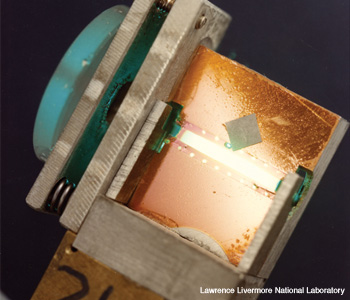 Actual soft X-ray Novette targets.
Actual soft X-ray Novette targets.
The “laboratory” X-ray laser
What Livermore carefully called the “laboratory” X-ray laser project didn’t start until the bomb-driven laser worked. Getting time on the fusion lasers wasn’t easy, but the experimental logistics were much easier. Fusion lasers delivered far less pump energy, but they could fire multiple shots a day, and the test equipment could be used repeatedly.
Initially, Hagelstein proposed a two-stage process, with the fusion laser first generating a plasma, then high-energy photons from the plasma exciting X-ray laser action in another material. In initial experiments, the researchers sought to strip chromium atoms of all but three electrons, hoping that photons from the plasma would excite laser emission from the hydrogen-like fluorine gas confined inside a chromium foil. However, the targets proved too complex to fabricate and test adequately with the two-beam Novette laser.
Next, they tried a variation on a Russian proposal for collisional excitation of 3p-3s transitions of neon-like ions. Hagel-stein’s idea was to blast outer electrons off heavy atoms, leaving only 10 inner electrons in a neon-like configuration. Collisions with free electrons in the plasma would excite 2p electrons to the 3p level, from which they could drop to the 3s level and emit soft X-rays. They deposited selenium on thin plastic, hoping Novette could ionize it to neon-like Se+24, creating a plasma with electron distribution that could guide X-rays along the axis of the cylindrical plasma. Initial experiments produced neon-like ions but no sign of X-ray laser amplification, so experimenters doubled pump-pulse duration to 500 ps. In the next test, on July 13, 1984, “the X-ray lines practically burned a hole in the film,” recalled Dennis Matthews, head of the experimenters. However, their spectrometer couldn’t identify what lines were emitted. They had expected strong emission at 18.3 nm, but a new spectrometer identified the strong emission as being on 20.6 and 20.9 nm lines of neon-like selenium. They measured a gain-length product of about 6.5 and amplification of about 700, which they considered convincing evidence of X-ray gain.
Livermore was proud of the achievement and promoted it as the first laboratory X-ray laser. Yet when Matthews described the experiments at the American Physical Society’s October 1984 Plasma Physics Meeting in Boston, he shared the spotlight with Szymon Suckewer of Princeton University, who had measured a gain-length product of 6.5 on the 18.2-nm carbon line and amplification of about 100, more than Pert had reported. Suckewer used a 300-J CO2 laser, less powerful than Novette but far smaller and less expensive, and confined the plasma magnetically.
Shorter wavelengths and smaller lasers
The selenium experiments marked a major milestone for Livermore, but had two important limitations. The 20-nm wavelength is relatively long. Biological imaging researchers wanted wavelengths shorter than 4.5 nm, and some definitions of X-rays include only wavelengths shorter than 10 nm. And although fusion laser shots cost orders of magnitude less than nuclear tests, the giant 20-beam Nova laser occupied its own building, and could fire only a few shots a day, each costing $30,000. Researchers wanted a laboratory laser that could fit in their laboratory.
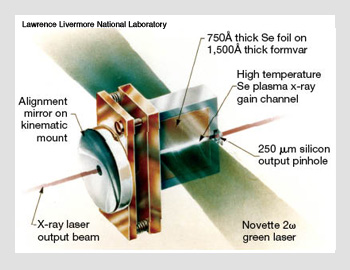 Novette Target. Light from the two Novette arms was focused onto opposite sides of a selenium foil target in Livermore’s X-ray laser.
Novette Target. Light from the two Novette arms was focused onto opposite sides of a selenium foil target in Livermore’s X-ray laser.
The logical way to shorter wavelengths was by using neon-like ions of heavier elements. Molybdenum brought Livermore to 13.3 nm, but Nova didn’t have the power to reach 4.5 nm with heavier neon-like ions. Reaching that target required shifting to nickel-like ions, heavy elements stripped of all but their 28 innermost electrons. Europium was first, at 7.1 nm, and Livermore later reached 4.316 nm in tungsten.
Suckewer had used a comparatively small laser, so he could fire pulses every three minutes, making experiments much easier than with Novette or Nova. He later increased the gain-length product to 8, producing 3-mJ X-ray pulses with beam divergence an impressively small five milliradians. Seeking high gain in a tabletop laser, but getting high gain with a tabletop laser required careful tailoring of pulses. Hagelstein, who moved to MIT in 1986, devised a dual-pulse approach, with the first pulse ionizing the plasma and the second exciting the ions to produce a population inversion in nickel-like niobium. Jim Dunn of Livermore later used a pair of 5-J pulses—the first lasting a nanosecond and the second a picosecond, with peak power 1,000 times higher—to collisionally excite stimulated emission from nickel-like palladium at 14.7 nm.
Continued refinements have increased peak power and reduced the pulse duration of tabletop lasers, yielding better X-ray lasers. By directing the pump beam at a grazing angle along a laser-produced cylindrical plasma, researchers realized an increased interaction length and energy transfer. Pumping with 8-ps, 1-J pulses at a 5-Hz repetition rate, Jorge Rocca at Colorado State University has produced saturated gain at 13.2 nm from nickel-like cadmium (Cd+20). His group also observed amplification, but not saturated gain, at 10.9 nm from nickel-like tellurium (Te+24).
Lacking mirrors suitable for X-ray oscillators, all those X-ray laser demonstrations generated only amplified spontaneous emission with limited coherence. Early this year, Rocca’s group reported an important new twist—aiming high harmonics from a titanium-sapphire laser into the excited plasma. Where plasma gain matched a harmonic frequency, the plasma amplified the harmonic seed pulse, generating gain-saturated output at 18.9 nm from nickel-like molybdenum and 13.9 nm from nickel-like silver. Those experiments are a big step toward a practical coherent tabletop X-ray source, and the shorter wavelength is in a band that is attractive for future generations of semiconductor photolithography.
X-ray free-electron lasers and new applications
Big X-ray lasers have their place in generating shorter X-ray wavelengths. Back in 1975, Chapline and Wood suggested that an electron beam passing through a periodic electric or magnetic field could generate stimulated emission at X-ray wavelengths. The idea came from John Madey’s pioneering free-electron laser work at Stanford University. Madey’s first success was in the infrared, but more energetic electrons and short-period magnets promised shorter wavelengths.
In the past few years, free-electron lasers have reached X-ray wavelengths. The first in the soft X-ray range was the free-electron laser in Hamburg, also called FLASH, which began user operation in 2005 at the Deutsches Elektronen-Synchrotron (DESY) in Hamburg, Germany. It has now been upgraded to allow tuning from 6.5 to 47 nm, and in October it generated a train of fast pulses at a record short wavelength of 6.5 nm.
Next year, XFEL will be surpassed by the Linac Coherent Light Source (LCLS) being built at the Stanford Linear Accelerator Center. It will use the last kilometer of SLAC’s linear accelerator to pump electrons to 4.5 to 14.3 GeV of energy, then pass the beam through 112 m of undulator magnets to generate hard X-ray pulses at 0.15 to 1.5 nm lasting 1 to 230 fs.
Livermore is among the labs working on LCLS, and, when the new facility begins operation next year, it may eclipse a couple of records that Livermore has kept under security wraps for more than two decades—the shortest X-ray wavelength and the brightest source of hard X-rays. Delivering a trillion X-ray photons per pulse, LCLS should be 10 billion times brighter than today’s most powerful X-ray synchrotron sources.
But pulses from LCLS won’t zap enemy nuclear warheads or other military targets in outer space. Instead they will illuminate the structure of proteins, extreme states of matter, chemical dynamics, nanoscale dynamics and ultrafast phenomena. Those were among the research targets that Chapline and Wood envisioned 30 years ago, before they turned to missile defense.
[ Jeff Hecht is a science and technology writer based in Boston, Mass., U.S.A. ]
References and Resources
>> J.G. Kepros et al. “Experimental evidence of an X-ray laser,” Proc. Natl. Acad. Sci. USA 69, 1744-5 (1972).
>> ”X-ray lasers: A status report,” Laser Focus, 41-6 (Nov. 1973).
>> R.W. Waynant and R.C. Elton. “Review of short-wavelength laser research,” Proceedings of the IEEE 64, 1059-92 (July 1976).
>> J. Hecht. Beam Weapons: The Next Arms Race, Plenum, 1984.
>> G. Chapline and L. Wood. “X-ray lasers,” Phys. Today 40-8 (June 1975).
>> P. Jaegle et al. “Super radiant line in the soft X-ray range,” Phys. Rev. Lett. 33, 1070-3 (1974).
>> C.A. Robinson Jr. “Advanced made on high-energy laser,” Aviation Week & Space Technology, pp. 25-7 (Feb. 23, 1981).
>> L.A. Vainshtein et al. “Stimulated emission in far ultraviolet due to transitions in multiply charged neon-like lines,” Soviet J. Quantum Electron. 8, 239-42 (1978).
>> D. Jacoby et al. “Observation of gain in a possible extreme-ultraviolet lasing system,” Opt. Comm. 37, 193-6 (1981).
>> M. Rosen and P. Hagelstein. “X-ray lasing: theory,” Energy & Technology Review Nov 1985, pp. 2-8 (Lawrence Livermore National Laboratory).
>> D.L. Matthews et al. “Demonstration of a soft X-ray amplifier,” Phys. Rev. Lett. 54, 110-3 (1985).
>> S. Suckewer et al. "Amplification of stimulated soft-X-ray emission in a confined plasma column," Phys. Rev. Lett. 55, 1753-6 (1985).
>> S. Suckewer et al. "Divergence measurements of soft X-ray laser beam," Phys. Rev. Lett 57, 1004-7 (1986).
>> B.J. MacGowan et al. “Demonstration of X-ray amplifiers near the carbon K edge,” Phys Rev. Lett. 65, 420-3 (1990).
>> W.J. Broad, Teller’s War: The Top-Secret Story Behind the Star Wars Deception, Simon & Schuster, 1992.
>> D.L. Matthews. “The X-Ray Laser,” in J. Hecht, Laser Pioneers, Academic Press, 269-83, 1992.
>> J. Nilsen. "Legacy of the X-ray Laser Program," Lawrence Livermore National Laboratory report, UCRL-52000-94-11 in Energy & Technology Review, 13-21 (November 1994).
>> J. Dunn et al. “Demonstration of X-ray amplification in transient gain nickel-like palladium scheme,” Phys. Rev. Lett. 80(13), 2825-8 (1998).
>> J. Nilsen. "Reminiscing about the early years of the X-ray laser," Quantum Electronics 33, 1-2 (2003).
>> J.J. Rocca et al. “Saturated 13.2 nm high-repetition-rate laser in nickel-like cadmium” Opt. Lett. 30, 2581 (2005).
>> Y. Wang et al. “Demonstration of high-repetition-rate tabletop soft-X-ray lasers with saturated output at wavelengths down to 13.9 nm and gain down to 10.9 nm,” Phys. Rev. A 72, 053807 (2005).
>> N. Hey. The Star Wars Enigma, Potomac Books, Washington, 2006.
>> Y. Wang et al. “Phase-coherent injection-seeded table-top soft-X-ray lasers at 18.9 nm and 13.9 nm,” Nature Photon. 2, 94-8 (2008).
>> XFEL
>> Linac Coherent Light Source
